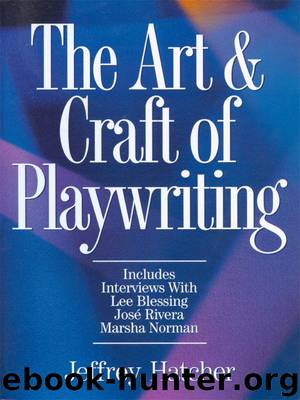The Art and Craft of Playwriting by Jeffery Hatcher

Author:Jeffery Hatcher [Hatcher, Jeffery]
Language: eng
Format: epub
Tags: book, ebook
ISBN: 9781884910067
Publisher: F+W Media
Published: 2011-05-02T04:00:00+00:00
In both presentational monologues, an intriguing, articulate and engaging character presents information to the audience. It's information we need to know before the play can progress. Where is the conflict? Where is the action? What is the need to tell?
In Equus, Dr. Dysart is engaged in solving a mystery. Why did Alan Strang blind six horses? He needs to find the solution to the mystery. And he needs to understand why his life of the mind feels so emotionally incomplete compared to that of the boy charged with the violent act he has been asked to investigate. Dr. Dysart needs to solve the mystery, but he also needs to make sense of his own life. He is a psychiatrist, and he needs a listener.
In Richard III, the Duke of Gloucester is about to set in motion the murderous plot that will bring him the crown. He must establish his background—the pains, the slights, the resentment. He must establish his ability—his chameleonlike nature, his strategic thinking, his wit. And, like many men of action, he must have a sounding board for his plans, his “brainstorming.” Richard must commit crimes to gain the throne, and he needs a confidant and coconspirator.
In each case, the character is either in conflict or is about to enter conflict. In the midst of action, he needs someone to hear his story. The audience fills his need.
In review, then, representational exposition requires a subtle, sometimes coded, but dramatically active approach. Presentational exposition may be more overt in its delivery of information but must play by the same taut dramatic rules to be dramatically effective.
TWO WAYS TO START THE JOURNEY
A play is a journey, both for the characters in the play and for the audience attending it. Kira Obolensky, a talented playwright who's writing a stage adaptation of Don Quixote for Trinity Rep, said to me once, “You begin a play on a highway. Either you drop the audience right onto the fast lane, or you bring them down slowly off the entrance ramp.” A play can start with a bang and we're off, or it can begin by slower increments. There are good arguments for both methods. Let's title each: We're off! and Slow Immersion.
We're Off!
We live in a caffeinated time. A late twentieth-century theater audience is much more apt to be attuned to the speed and rhythms of popular music, film and electronic entertainment (TV, video, the Internet) than to the slower tempos of the past. For the modern audience, slow and easy may be dull and deadly. The faster the play gets out of the starting gate, the better. There's an immediate rush, a sudden jolt to the senses a play can achieve by starting with a bang. But what can deliver the bang?
It could be an image. An onstage murder. A dance. A rapid entrance. A joke. Anything theatrical that arrests the eye and ear and connects the audience immediately to the action that is taking place and the story that is about to be told.
Download
This site does not store any files on its server. We only index and link to content provided by other sites. Please contact the content providers to delete copyright contents if any and email us, we'll remove relevant links or contents immediately.
| Acting & Auditioning | Broadway & Musicals |
| Circus | Direction & Production |
| History & Criticism | Miming |
| Playwriting | Puppets & Puppetry |
| Stage Lighting | Stagecraft |
Call Me by Your Name by André Aciman(20347)
Ready Player One by Cline Ernest(14488)
How to Be a Bawse: A Guide to Conquering Life by Lilly Singh(7360)
Wiseguy by Nicholas Pileggi(5639)
The Kite Runner by Khaled Hosseini(5061)
On Writing A Memoir of the Craft by Stephen King(4846)
Audition by Ryu Murakami(4817)
The Crown by Robert Lacey(4709)
Call me by your name by Andre Aciman(4592)
Gerald's Game by Stephen King(4552)
Harry Potter and the Cursed Child: The Journey by Harry Potter Theatrical Productions(4425)
Dialogue by Robert McKee(4303)
The Perils of Being Moderately Famous by Soha Ali Khan(4154)
Dynamic Alignment Through Imagery by Eric Franklin(4093)
Apollo 8 by Jeffrey Kluger(3618)
Seriously... I'm Kidding by Ellen DeGeneres(3558)
The Inner Game of Tennis by W. Timothy Gallwey(3555)
How to be Champion: My Autobiography by Sarah Millican(3543)
Darker by E L James(3461)
